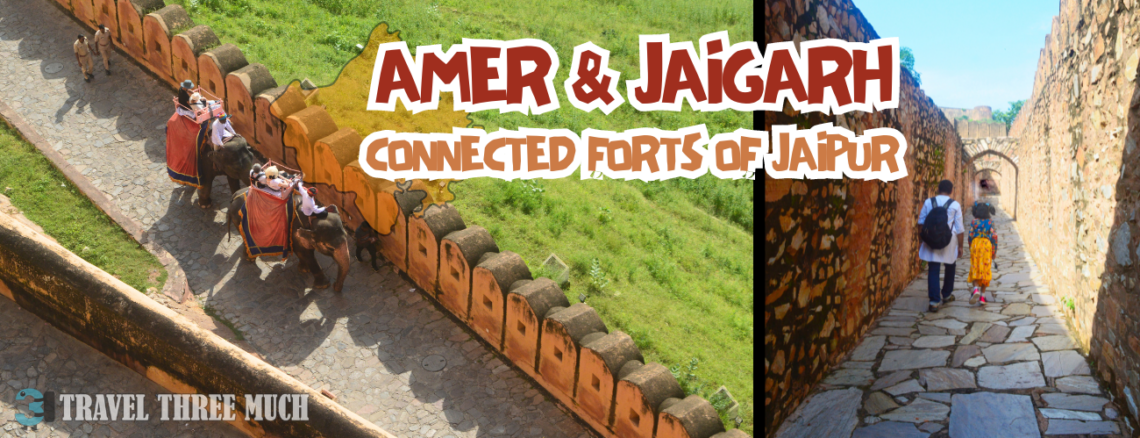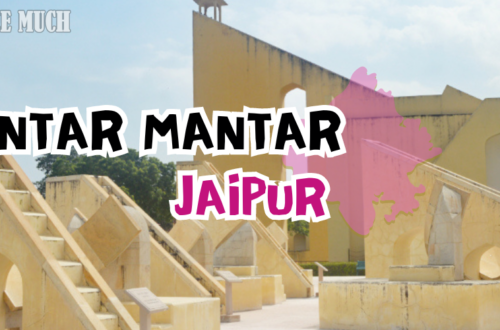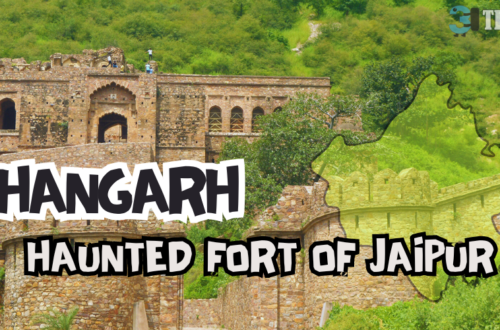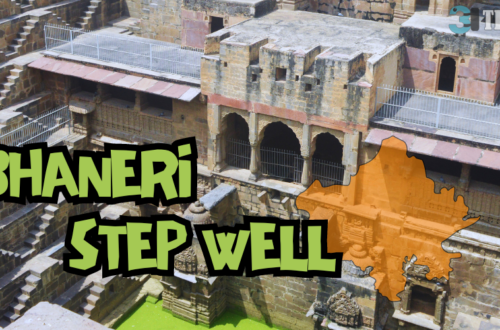
Amer Fort and Jaigarh – The Connected Forts of Jaipur
Amer Fort
We had planned half a day, starting early to cover Amer and Jaigarh fort. Even before reaching the fort, we stopped on the way to soak in the views of the fort from a distance.


The guides at Amer fort are very very very perseverant.
The guides and touts warned us that we’d either get lost or we’d miss out on parts of the fort without their ‘guidance’.
Rest assured that you’re neither at a risk of getting lost thanks to the well-marked paths nor are you at a risk of missing portions of the fort thanks to the detailed layout maps that can be found online fairly easily.
The entrance is a beautiful structure with large murals.
Just past the entrance is the Hall of Common Audience or the Diwan-I-Aam. The hall is patterned after Mughal courts and has a seating space for the important nobles and an elevated space for the throne of the king. A little way after this is the Sukh Mandir or the Diwan-I-Khas, the Hall of Special Audience.
The arrangements made for cooling the interiors through natural cross ventilation with the air passing through what must’ve been circulating water are ingenious, in an era where electricity was unheard of but summers that set the mercury soaring were commonplace.
YOU MAY ALSO LIKE : OUR 4 DAY JAIPUR ITINERARY
Close to the Sukh Mandir is the Sheesh Mahal or the Mirror Hall. This is a structure that has plastered interiors with openings where either metallic pieces polished to a high degree of shine or mirrors were inlaid. The overall effect is quite striking.

It is said that a single candle is sufficient to light up an entire room thanks to the reflections by the mirrors.
Both the mirrors and murals are in a relatively good state of preservation, considering the time they’ve weathered the elements.

The views from the upper stories of the fort are breathtaking. We could see some decorated elephants that were carrying tourists on a procession along the ramparts of the fort! Also visible were some gardens and a stage-like structure in the lake neighbouring the fort.
A little bit of wandering brought us to the palace of Raja Man Singh with its baradari or pavilion and the Zenani Deorhi, or the apartments of the Royal ladies.
This served both as a residence of queen-mothers and those of the consorts of the king’s harem. We were almost at the end of our trail of the fort when we came across what looked like vessels and kitchen utensils for giants!
Apparently, such was the scale of operations needed to keep the royal household and their attendants fed! When we were almost at the end of the path to the outside of the fort, we came across a sign that said ‘Way To Tunnel’.

This was the famed tunnel that led to Jaigarh fort from Amer fort, about which we’d read during our research for this trip.
But alas, the path was barred with a locked gate!
The Rajasthan Police personnel stationed there for security kindly informed us that once we exited the fort, we’d not be allowed back in the same way. So they asked us wait around for 15-20 minutes by when the gate to the tunnel should be unlocked.
As we were waiting around, 5 minutes later, a jolly gentleman came carrying a bunch of keys, bade us to follow him. He unlocked the gate at Amer fort end and with his pace, put us ’youngsters’ to shame as he made his way to unlock the other side that led to the Jaigarh fort.
The tunnel walk
The tunnel started off with an underground stretch which is well lit with the exception of where it reaches surface level. But daylight does filter in sufficiently to not leave you in total darkness. There were no bats in this segment of the tunnel.
The tunnel levelled off after about 10 minutes of walking and led to another gate past which it was a path with tall walls on either side and not many people in sight.

This is because most tourists prefer to drive between the forts (a distance of 5 km or 6 km) rather than take the tunnel.
The tunnel is only about 1.5 km but involves a 20 minute hike in the final stretch to Jaigarh fort.
We enjoyed the walk and were kept company by bulbuls, parakeets, mynahs and squirrels.

There are various lookout points on the way to Jaigarh fort which offer sweeping views of the valley below in which Amer fort sits and the surrounding hills.

Jaigarh Fort
The fort is located on the top of a hill, locally called Cheel ka Teela. This gives it a naturally advantageous position making it a very difficult fort to attack and conquer.
This strategically important position is also one of the reasons the tunnel existed between Amer fort and Jaigarh fort so that in the event of an attack on Amer fort, Jaigarh fort could be a secure fallback position.

A very interesting aspect of this fort is the extensive foundry facilities that exist within its walls for casting cannons.
There is also an elaborate drilling setup which was oxen-powered and used a system of underground cogs and wheels to turn the shafts of drill heads, which could in-turn be fitted with massive ‘drill bits’ that bored the cast cannon blanks to barrels of the intended size. The foundries could attain temperatures hot enough to melt metal for the castings through the natural siting of a furnace which used the air draft between the valleys to heat the metal.

An impressive feat of this setup is the cannon Jaivan, which was cast in these foundries and is now situated in Jaigarh fort. This cannon was one of the largest in the world when it was cast. Another similar cannon is named the Bajrangvan and is smaller than the Jaivan, but nevertheless is quite impressive. There’s a model of the drilling setup which makes it very easy to understand the mechanism as some of the cogs and wheels were ingeniously situated underground, out of sight.
After the foundry complex, we visited the armoury and museum within the fort which offers a glimpse into the weapons of war and photographs of royalty from the 18th and 19th centuries.
We then made our way to the gardens which are fed by water harvesting structures in the surrounding Aravalli hills and have underground water storage areas to prevent loss by evaporation.
The view from the surrounding walls of the gardens and the tall archways that framed the surrounding mountains was otherworldly and one can be forgiven for mistaking reality for a dream!


We strolled around some more and found slices of royal life in the form of a pavilion that allowed the royalty to enjoy a puppet show while having their meal, with arrangements for the women of the royal household to enjoy the show from behind stone jaalis in a balcony, shielding them from public view, as was the custom of those years.
YOU MAY ALSO LIKE : ,BHANGARH FORT – MYSTERIOUSLY MAGNIFICENT!

Another interesting scene was the separate dining halls for the men and the women of the royal households where the king and queen broke bread with the noblemen and wives of the noblemen separately, respectively.
And with that, our half day of fort tours came to an end.




